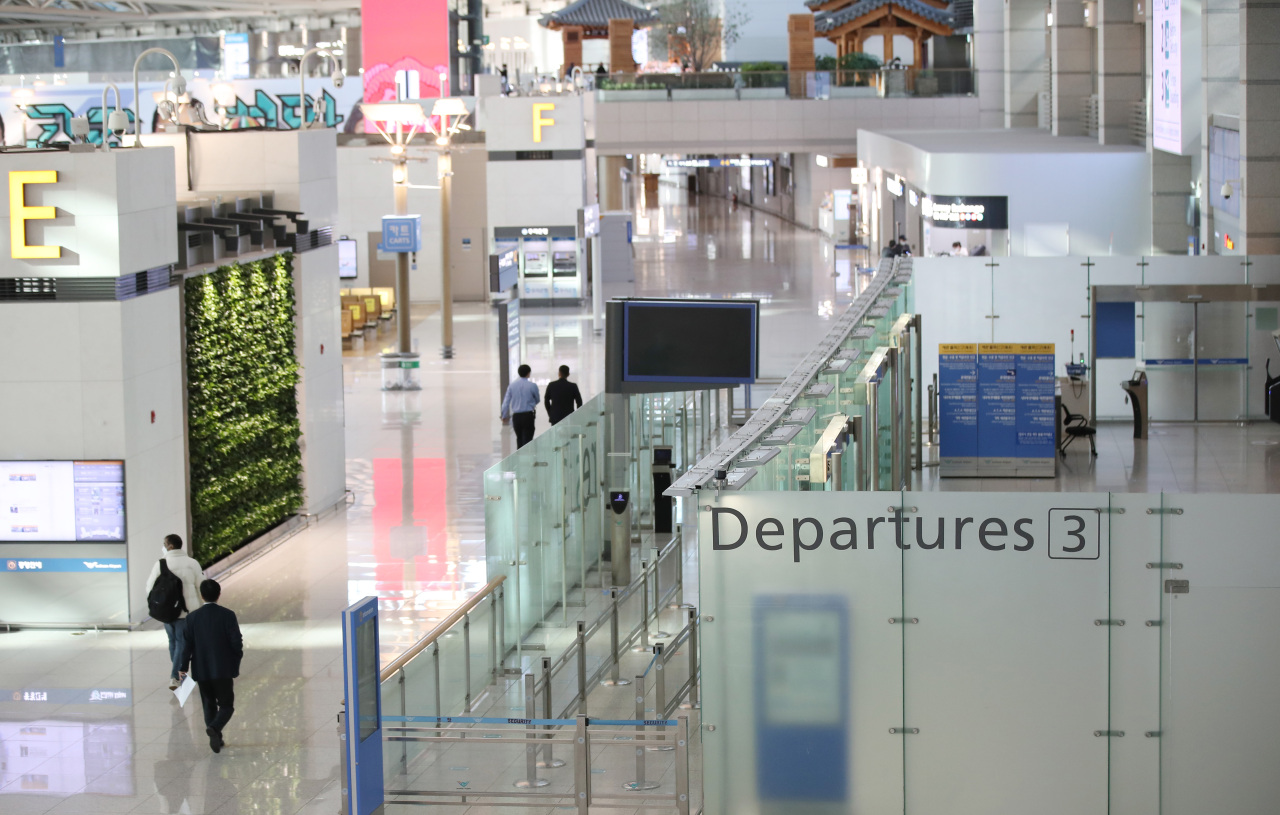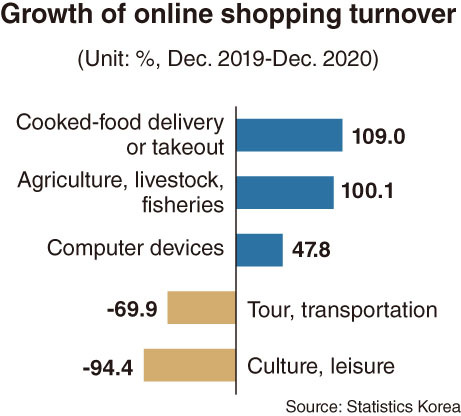[News Focus] COVID-19 causes historic gap in online sales by product type
Turnover for tours, culture plunges 70-94 percent in a year
By Kim Yon-sePublished : Feb. 25, 2021 - 15:35

SEJONG -- The novel coronavirus was found to have brought a seriously widening disparity in the online sales performances of local retailers by product segment and business type.
South Koreans have sharply increased their online spending on agricultural, livestock and fisheries products as the cut back on dining out amid the pandemic.
According to Statistics Korea, the monthly turnover of retailers selling products from agriculture, livestock and fisheries online -- for homemade food -- reached 638.2 billion won ($575.4 million) in December 2020.
This marked the second-highest number in history, next to the record-high of 736.8 billion won in September 2020, which was a particular occasion affected by the Chuseok, or Korean thanksgiving, holidays.
Compared to December 2019, when the figure was just 318.9 billion won, online shopping transactions for the product segment surged by 100.1 percent in just a year. The growth rate over the past two years reached 150.7 percent from 254.2 billion won in December 2018.

In a similar vein, online transactions for groceries, water and beverages showed a noteworthy increase to hit 2 trillion won in December 2020.
This contrasted with 1.2 trillion won for the segment in December 2019, 925.6 billion won in December 2018 and 709.6 billion won in December 2017.
Data also showed historic growth in the online sales of food delivery or takeout services (109 percent growth on-year) and computer devices (47.8 percent) -- due to online classes for students and the telecommuting of many salaried workers -- for the past year. The situation caused a jump in retail prices of both desktops and laptops from rapidly grown demand at home and abroad.
Apart from COVID-19, the rapid growth of online shopping has been backed by systematic parcel delivery services, which send products to consumers across the country in 24 to 72 hours generally.
Almost every category of product -- from food and cosmetics to clothing, home appliances and furniture -- can be found online. A growing proportion of consumers were found to have purchased goods offered by department stores and large discount chains via the internet as well.
An official of the Ministry of Agriculture, Food and Rural Affairs said that “data shows changing consumption trends like diversification of food retail services or preference for convenience food.”
Local specialties including fresh agricultural products in rural districts nationwide are also drawing popularity online.
“Farmers from nine provinces deliver consumers soy sauce-marinated crab, leaf mustard kimchi, groundsel-flavored macaroons and makgeolli,” the official said.
He said urbanites were attracted to homemade food and liquor products from microbusinesses in rural areas on the back of direct deals online. “The consumption trend is positive in terms of elevating the income level of farming, forestry and fishery households.”
In contrast, online sales for tours, transportation, culture and leisure activities have declined sharply.
The monthly turnover of tourism and transportation services was 470.8 billion won in December 2020. This posted a 69.9 percent slide from 1.56 trillion won in December 2019, and was also lower than 1.39 trillion won in December 2018 and 1.27 trillion won in December 2017.
The volume of online transactions for cultural and leisure activities plunged by 94.4 percent on-year -- from 183.4 billion won in December 2019 to 10.2 billion won in December 2020.
According to the Korea Immigration Service, the number of outbound Korean tourists reached 2.17 million in October 2019. But the figure declined by 96.6 percent to 72,832 in October 2020.
The tally for non-Korean inbound visitors fell from 1.68 million to 69,215 over the corresponding period.
By Kim Yon-se (kys@heraldcorp.com)









![[Kim Seong-kon] Democracy and the future of South Korea](http://res.heraldm.com/phpwas/restmb_idxmake.php?idx=644&simg=/content/image/2024/04/16/20240416050802_0.jpg&u=)







![[KH Explains] Hyundai's full hybrid edge to pay off amid slow transition to pure EVs](http://res.heraldm.com/phpwas/restmb_idxmake.php?idx=652&simg=/content/image/2024/04/18/20240418050645_0.jpg&u=20240418181020)

![[Today’s K-pop] Zico drops snippet of collaboration with Jennie](http://res.heraldm.com/phpwas/restmb_idxmake.php?idx=642&simg=/content/image/2024/04/18/20240418050702_0.jpg&u=)